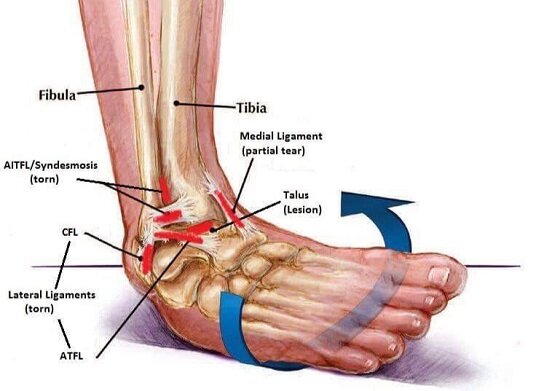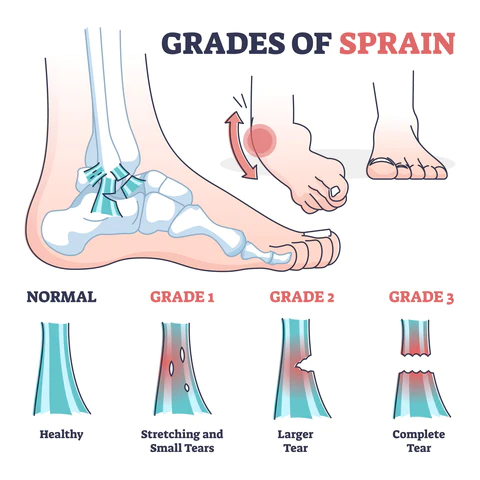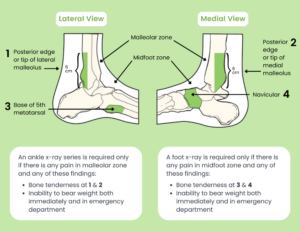The Best Ankle Sprain Treatment in Toronto : Address All Of The Problems
Lateral ankle sprains are one of the most common injuries on the planet! Athletes that are involved in basketball, soccer, ballet/dance or running, are reported to represent as much as 40% of all athletic injuries. There are a reported 23,000 + sprains per day in the United States alone. However, most physiotherapists and chiropractors don’t take this injury seriously enough and don’t provide care that addresses the actual PROBLEM. We think we provide some of the best ankle sprain treatment in Toronto because we address all of the injuries that occur with an ankle sprain.
The PROBLEM is that ankle sprains typically recur over and over again even with proper corrective care and rehabilitation programs; even more without rehab. The best predictor of a future ankle sprain is the history of previous ones!
These injuries almost always heal by themselves with time. The PROBLEM stems from the fact that after an ankle sprain, there are usually injuries and dysfunction of not just the injured ligaments; the joints, nervous system tissue, muscles and even structures far away from the site of an injury stop working properly. It is not just the ligaments that get stretched, but all the nerves that sense and move the ankle!
This is partially the reason why About 10-20% of people will go on to have Chronic ankle instability (CAI)

Why We Think We Provide The Best Ankle Sprain Treatment in Toronto
The SOLUTION to an ankle sprain is addressing all of the changes that occur to the body. Using manual therapy, acupuncture and proper corrective exercises, that not just eliminates your pain, but ensure that the nerves, muscles, ligaments and joints return to their pre-injury level.
To provide the best possible ankle sprain treatment in Toronto requires that your doctor or physiotherapist assesses the nerves, muscles and ligaments of the ankle after and injury and specifically addresses them if they are injured. As an example, electro-acupuncture is the single best tool to return the strength to a stretched ankle nerve after a sprain.
The Anatomy Of An Ankle Sprain

It is the job of the muscles (dynamic) and ligaments (static) to keep a joint in its normal range of motion. When forced outside of this normal range of motion, a joint is frequently injured.
Foot inversion and eversion during a sprain, when the ankle is “rolled”, an excessive amount of forced inversion or supination (plantar flexion-inversion-adduction combined) occurs. This stretches and strains ALL the tissues on the outside of the leg.
The muscles, primarily the peroneal (fibularis longus and brevis) muscles, respond dynamically to cause eversion and resist the rolling of the ankle. Sometimes they are unable to respond quickly enough and with enough force to stop the inversion, which then puts the ligaments and other soft tissues of the leg under strain. In other words, “if the magnitude of this supination moment exceeds the magnitude of a compensatory pronation moment (produced by the peroneal muscles and the lateral ligaments)”, an injury will result – we want strong peroneals and active nerves to respond!
It is the job of the nerves that control these muscles to respond quickly and forcefully. If these peroneal nerves are working properly then the muscles will be more likely to be activated in time and prevent the sprain. If not, like in the case of nerves that have been previously damaged by a sprain, the sprain is more likely to occur! Providing the best treatment for ankle sprains in Toronto or wherever you live requires your doctor to know this!
What Gets Injured During An Ankle Sprain
 If the strain is great enough, the tensile strength of the tissues and the ligaments is exceeded and damage occurs.
If the strain is great enough, the tensile strength of the tissues and the ligaments is exceeded and damage occurs.
The ligaments, namely the anterior talofibular ligament (ATFL) is the most commonly sprained (torn) ligament. With the tearing of the ATFL or greater force, the CFL can tear. The posterior talofibular ligament (PTFL) is typically only torn with severe ankle sprains and is often accompanied by fractures, dislocations or both.

Other soft tissue structures on the outside of the leg and ankle will also be put under excessive strain with damage to the following typically occurs:
- Talocrural (ankle) joint capsule and the ligamentous stabilizers of the subtalar (joint between calcaneous and talus) joint
- Fibularis longus and brevis muscles
- Superficial and Deep Fibular Nerves
- Subtalar or ankle synovial joint tissue
- Blood vessels
- Ankle Retinaculum
Key Point: More than just the ankle ligaments are damaged in a sprain
Certain factors will make an ankle sprain worse:
- Landing with more plantar flexion
- Landing with greater force
- A history of previous sprains and/or greater ligament laxity
Also, certain (biomechanical) factors will make some people predisposed to first-time ankle sprains:
- Increased tibial varum
- Non-pathologic talar tilt
- Poor Postural Control and Poor Proprioception
- Uneven strength between plantar flexors vs. dorsiflexors and evertors vs. invertors
Ankle Sprain Signs, Symptoms and Prognosis / Outlook

The extent of symptoms experienced depends on the number of ligaments that are torn, the degree to which they are torn, and the degree of injury to the bones, nerves or muscles in the area. More ligament damage and injury to the adjacent structures will lead to more pain, swelling, instability and dysfunction. More damage to the adjacent structures will also lead to longer recovery times and greater dysfunction.
Most ankle sprains can be categorized as grade 1 or grade 2 ankle sprains, in which the ATFL (and or CFL and PTFL) are partially torn. These will resolve in weeks to months without complications in terms of symptoms and often with a full return to normal activity. Grade 3 tears are those in which the ligaments are completely ruptured, which often occurs with associated fractures, and necessitates a surgical consult.
However, studies have shown that 55%-72% of patients have residual symptoms at 6 weeks to 18 months and that physiological dysfunction may persist long after symptoms do.
Bruising on the outside of the leg and foot is common as the ruptured ligament’s blood vessels drain into the foot.
Pain from the tearing or aggravation of nerve fibres in the ligaments, bones, joints and muscles of the ankle is usually dull with rest, sharp with weight-bearing or activity, and can be of moderate to high intensity. A failure of any damaged nerves to heal is what leads to the chronicity of ankle sprains in most cases.

Swelling can be mild to serve depending on the degree of bleeding and inflammatory response to the injury. It is most notable on the dorsal (top) and lateral (outside) surface of the foot. More oedema is associated with greater pain and functional limitations
Numbness and tingling are uncommon and unlikely and would necessitate a visit to your health care professional or chiropractor. Weakness is very common because of the pain and arthrogenic inhibition, but an inability to move the foot would necessitate and immediate emergency room visit.
X-RAY use is guided by the Ottawa Ankle Rules, which are excellent at identifying if imaging is needed to rule out a Fracture of the ankle.
Diagnosis can be easily made with orthopaedic testing and examination by a chiropractor. There is generally no need for an ultrasound, MRI, or CAT scan unless surgery is required or recommended.
What Are The Consequences of An Ankle Sprain
The most important part of treating an ankle sprain is often the most overlooked. While it is important to address and reduce one’s pain, there is considerable research showing that there are other physiological changes that result from an ankle sprain that contribute to the high reoccurrence rate of ankle sprains. Understanding and addressing these concerns is vital for a full and proper recovery
The following are some of the noted changes that occur with single or multiple sprains that should be addressed with manual and rehab care. It is shocking how long this list of consequences is beyond simple ligament damage!
Neurological Changes – Dynamic Stability Changes
- Peroneal muscle reflexes (muscle spindle activity) are altered and reduced muscle responsiveness
- Reduced ankle proprioception and joint angle/positioning sense impairment
- common peroneal nerve palsy (NERVE INJURY) has been demonstrated in theperoneal muscles in lateral acute ankle sprains
- = slower nerve speed and reduced skin sensation
- peroneal muscles demonstrate slowed reflex response times to inversion = less able to guard against inversion sprains
- Central sensitization and increased pain sensitivity at the level of the spinal cord towards ankle symptoms
- Reduced ankle inversion and eversion strength
- Bilateral (Both sides of the body!!!) reduction in gluteal muscle activation
- Easily measured reductions in balance and postural control
Acupuncture, which works by talking to the nervous system, works great to address these concerns!
Joint Changes – Static Stability Changes
- Subluxation or malpositioning of the distal or lower joint between the tibia and fibula that makes up part of the ankle complex. This may promote an increased range of the talus, increasing the risk of future ankle sprains > this responds well to treatment
- Reduced ankle flexibility (dorsiflxion) is associated with increased ankle sprain risk > I can improve this
- Ligament laxity of the ATFL, CFL, or PTFL ligament from previous ankle sprains leads to reduced static joint stability, increased range of motion and increase re-sprain risk > proper rehab care is needed to address this
- Repeated ankle sprains and CAI is associated with higher rates and earlier occurence of ankle arthritis: 3.37 times more likely to have osteophytes, or loose bodies, than those with asymptomatic ankles
- Synovial (joint lining) tissue inflammation after recurrent ankle sprains, which is due to impingement of hypertrophied synovial tissue between the respective bones of the ankle complex > can cause frequent swelling in the absence of rolling an ankle
Chronic Ankle Instability
Ankle Sprain Treatment and Rehab In Toronto
Addressing pain and dysfunction is vital in returning a sprained ankle back to proper function. A combination of self-care, LASER, sports taping, exercises and pain-modulating modalities like acupuncture, TENS, IFC are important to help manage your symptoms.
Ultimately, it is my goal to help you perform and move your best by addressing the aforementioned changes to the leg and ensuring the muscles, nerves and ligaments begin to function properly again. A combination of Active Release Therapy (ART), joint adjusting or mobilization, electroacupuncture and rehab exercises can help us get you there.
If you have any questions about how I can help you with an ankle or any other problem, please contact me.
